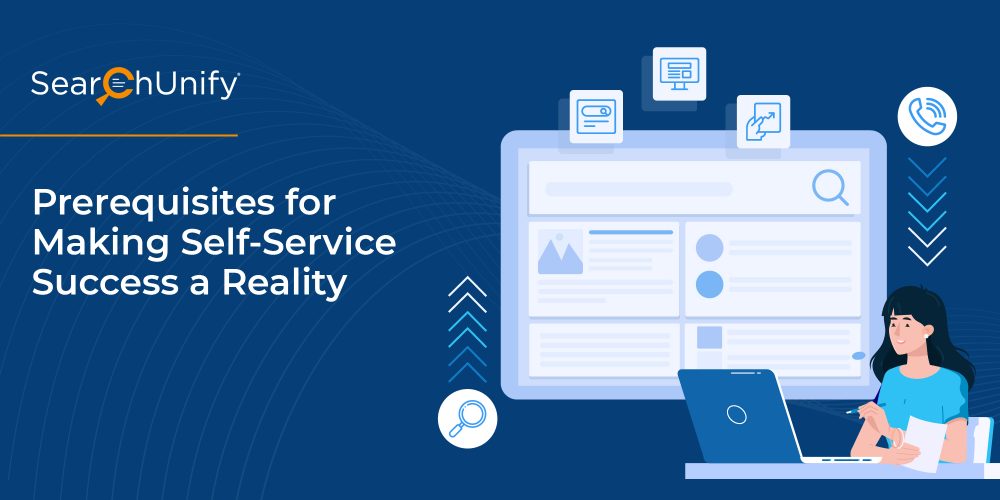
Businesses and customers both love self-service alike because a) it deflects the cases that the support has to otherwise personally assist and helps in resolving Level 1 queries, thus increasing the return on investment, and b) customers look for instant, or at least quick responses to their queries and self-service has proven to reduce customer churn rate and has influenced customer satisfaction rates positively.
According to a study by Dimension Data, 73% of customers prefer to use a company’s website, instead of using social media, SMS, and live chat for support. But having a self-service portal for your customer that is poorly organized, or managed is more damaging to your brand value than not having one.
Your customers looking for help to use your self-service portal would be quite an irony, wouldn’t it? Therefore, in this blog post, we’ll quickly discuss some prerequisites for making self-service success a reality.
1. Offer Unified Access to Data Repositories
The information in a company is usually dispersed across siloed data repositories. For accessing this information, a customer may have to hop tabs, jumping from one page to another. While a few clicks do not harm, there is no limit to what a customer considers a lot. So, creating a space where the scattered data can be accessed effortlessly increases the possibility of a customer to feel empowered, increasing the chances of self-service success.
2. Chalk-Out Your Target Audience
Whatever your line of business is, it is important to define who you have created the self-help portal for. How do you define the success of the portal and how do you plan to measure or quantify that success? And accordingly, have measurable goals for the portal, for example, improved case deflection, enhanced CSAT scores, elevated community engagement, increased cross-sale through contextual ads, and so on. Having clearly defined goals helps measure the ROI of the self-service portal.
3. Leverage ML to Deliver Relevant Results
Integrating a cognitive search engine enables the portal to understand the user better. The machine learning algorithm continuously learns from user behavior, tunes itself automatically, and delivers personalized content, based on their preference, behavior, nature of the query, and goal.
The cognitive technology monitors the user activities closely, right from when they search for a query until the end of their session and analyzes if they could successfully help themselves. The cognitive platform that’s equipped with ML thus recommend helpful as-you-type query suggestions and deliver similar paths or resolutions to other users facing similar challenges.
4. Encourage Self-Service Adoption
Self-service can only improve if it is adopted. If customers are struggling to figure where they could head to find answers, hand-holding the user and helping them help themselves can be a great strategy.
Redirect your customers – those who reach out to you via email, or by logging a case on your help center, or chatting with your help agents (live or virtual) – to your self-service portal by sharing the links to the self-help content.
5. Close the Loop Between Self-Service and Support
Consider a scenario where a user is not able to find the right solution on your self-service page and therefore, goes to your support page to log a case. Your case deflection mechanism or the search engine suggests a self-help article, but the user doesn’t find it useful and logs a case. Now, when a support agent works on the same case, he finds and suggests just the right resolution. This reflects that the information existed on your self-service portal, but the search engine could not display relevant content to the user.
A cognitive search engine automatically improves the relevancy score of content pieces that are used by support agents for the search query used by the customer. Hence, if your agents attach a particular article to resolve a case, that article should be displayed higher in the subsequent customer interactions. This helps improve the self-service success for future users searching for the same information.
6. Leverage Search Analytics
Quantifying any activity enables support managers to draw useful conclusions, such as through which channels the customers access the self-service portal, how many times they successfully land on solutions, where they get stuck, and why. This intelligence can be further segregated by geography, product, and the final outcome (case creation or deflection or conversion). You can use this intelligence to spot the search trends, identify the content gaps on your self-service portal, and even predict issues, and create helpful content to fill the gaps and proactively reduce caseload for your agents.
7. Offer Uniform UX Throughout Platforms
A uniform customer experience across channels that is simple and easy to access ensures better chances of a customer again routing for self-service portals. This can be done by making your self-service portals available for various devices. A BaseKit survey points out that 91% of websites are not compatible with mobile phones, further pointing out at the huge opportunity to conquer with a simple step of providing your self-service portal on mobile phones.
Want to master the art of self-service and case deflection? Here’s your complete guide!
Self-service success is a win-win for customers and businesses. Delight your customers and reduce your support cost by mastering the art of self-service. Here’s your complete guide to self-service. Download it now!










